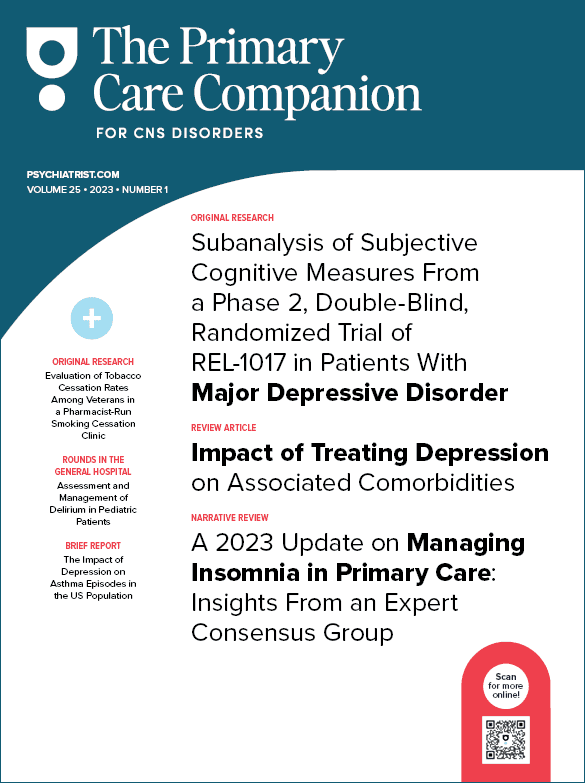Prim Care Companion CNS Disord 2023;25(2):22cr03379
To cite: Mahato K, Maben AJ, Sharma A. Psychosis and catatonia associated with West Nile virus. Prim Care Companion CNS Disord. 2023;25(2):22cr03379.
To share: https://doi.org/10.4088/PCC.22cr03379
© 2023 Physicians Postgraduate Press, Inc.
aUniversity of Nebraska Medical Center, College of Medicine, Omaha, Nebraska
bDepartment of Psychiatry, University of Nebraska Medical Center, Omaha, Nebraska
*Corresponding author: Ashish Sharma, MD, Department of Psychiatry, University of Nebraska Medical Center, 985575 Nebraska Medical Center, Omaha, NE 68198‐5575 ([email protected]).
West Nile virus (WNV) is a single-stranded RNA flavivirus that is commonly transmitted by mosquitoes. While psychosis has been linked to other flavivirus infections, WNV-associated psychosis is rare and has only been reported a few times in the literature. We present a unique case of WNV-associated psychosis complicated by catatonia.
Case Report
A 60-year-old man presented to the emergency department after a 4-day period of altered mental status, fever with chills, and headache. His white blood cell (WBC) count was 12.7 x 109/L, and other laboratory results were unremarkable. Empiric antibiotics were started for suspected meningitis. After 2 days, he was afebrile with a WBC count within normal limits, and antibiotics were discontinued. Head magnetic resonance imaging was nonspecific. The neurology department performed a lumbar puncture, with a WBC count of 74 x 109/L and polymorphonuclear leukocytes of 14%, lymphocytes of 56%, monocytes of 30%, protein of 47 g/dL, and glucose of 65 mg/dL, which was consistent with viral meningitis. A meningitis panel was negative for cryptococcal antigen, HIV, and Lyme disease, but the cerebrospinal fluid serology was positive for WNV.
Months later, he presented with paranoia and persecutory delusions of police pursuing him and cars spying on his house. He had no prior psychiatric history. He was resistant to redirection, stared out the window, abstained from activities, and became nonverbal. He had no exposure to toxins, substances, or other environmental exposure factors. He believed there was flesh, blood, and babies in his food. He was admitted to the inpatient psychiatry floor and treated with olanzapine 10 mg. His symptoms started to improve. However, he later developed catatonic symptoms including mutism, echolalia, and withdrawal.
He was transferred to the medical floor. His Bush-Francis Catatonia Rating Scale1 score was 11. After starting lorazepam 2 mg intravenous 3 times/d, the score decreased to 1. Olanzapine was discontinued to avoid worsening of catatonia. After 2 days of lorazepam, he improved and could engage in conversation. Lorazepam was tapered over 3 weeks. His catatonia resolved, and he was restarted on olanzapine and discharged home in stable condition.
Discussion
WNV is the most common mosquito-borne illness in the continental US.2 Most WNV infections are asymptomatic. Symptomatic patients typically present with self-limiting fever, myalgias, and malaise. Approximately 1 in 150 people develop neuroinvasive disease, such as meningitis, encephalitis, or flaccid paralysis.3,4
Along with WNV, the Flaviviridae family also includes Zika, Powassan, dengue, and yellow fever viruses. Zika,5 Powassan,6 and dengue7 viruses have been associated with psychosis. There are 2 reported cases, to our knowledge, of WNV-associated psychosis involving (1) a renal transplant patient with meningitis and psychosis8 and (2) a patient with psychosis, ataxia, and facial dyskinesia.9 Neither involved catatonia.
There are links between flaviviral pathophysiology, immunology, and psychosis. Schizophrenia geographic distribution has been linked to tick-born encephalitis, including tick-associated flaviviruses.10 A murine study11 found that genome components of flaviviruses, including the Kunjin WNV subtype,12 had similarities to abnormal protein-encoding sequences in schizophrenia. RNA virus encephalitis was also linked to cerebellar neuroinflammation,13 which is associated with psychosis in clinical and laboratory research.14
Akinetic catatonia, as seen in our patient, has complications including malnutrition, dehydration, pressure ulcers, and venous thromboembolism.15,16 Catatonia is primarily seen in psychiatric conditions, but it is also seen in a variety of medical conditions such as infections.17 A systematic review found that 20% of catatonia has a medical cause, and central nervous system inflammation represents 29% of these cases.18 Catatonia is not yet reported with WNV, to our knowledge, but a report exists of catatonia associated with dengue fever.19 Catatonia has been associated with autoimmune conditions, such as N-methyl-D-aspartate receptor encephalitis,20 and elevated acute phase reactants, such as C-reactive protein.21 Regardless of cause, response rates to treatment with benzodiazepines and electroconvulsive therapy are high.22,23 This suggests a common pathophysiology behind catatonia, such as immune system modulation.
In conclusion, we present a patient with no primary psychiatric diagnosis who developed psychosis and catatonia months following WNV encephalitis. This case, along with other similar flaviviral reports, builds the connection between neuropsychiatric symptoms and the immunologic basis of infectious diseases. Further research into the cognitive and functional outcomes of patients recovering from WNV illness will be important in understanding the overall illness burden and long-term psychiatric prognosis.
Published online: April 11, 2023.
Relevant financial relationships: None.
Funding/support: None.
Patient consent: Consent was received from the patient to publish the case report, and information has been de-identified to protect anonymity.
ORCID: Kalika Mahato: https://orcid.org/0000-0003-3492-5522;
Alex J. Maben: https://orcid.org/0000-0003-4869-3945;
Ashish Sharma: https://orcid.org/0000-0003-1770-0567
References (23)

- Bush G, Fink M, Petrides G, et al. Catatonia, I: rating scale and standardized examination. Acta Psychiatr Scand. 1996;93(2):129–136. PubMed CrossRef
- CDC. West Nile Virus. Published June 2, 2022. Accessed July 12, 2022. https://www.cdc.gov/westnile/index.html
- Petersen LR, Brault AC, Nasci RS. West Nile virus: review of the literature. JAMA. 2013;310(3):308–315. PubMed CrossRef
- CDC. Final Cumulative Maps and Data | West Nile Virus. CDC website. Published January 5, 2022. Accessed July 12, 2022. https://www.cdc.gov/westnile/statsmaps/cumMapsData.html
- Corrêa-Oliveira GE, do Amaral JL, da Fonseca BAL, et al. Zika virus infection followed by a first episode of psychosis: another flavivirus leading to pure psychiatric symptomatology. Br J Psychiatry. 2017;39(4):381–382. PubMed CrossRef
- Wilson MS, Wherrett BA, Mahdy MS. Powassan virus meningoencephalitis: a case report. Can Med Assoc J. 1979;121(3):320–323. PubMed
- Dinakaran D, Sreeraj VS, Venkatasubramanian G. Dengue and psychiatry: manifestations, mechanisms, and management options. Indian J Psychol Med. 2022;44(5):429–435. PubMed CrossRef
- Hardinger KL, Miller B, Storch GA, et al. West Nile virus-associated meningoencephalitis in two chronically immunosuppressed renal transplant recipients. Am J Transplant. 2003;3(10):1312–1315. PubMed CrossRef
- Sheikh IS, Afreen E, Sheikh A. Unusual movement disorders and atypical magnetic resonance imaging (MRI) findings in patients with West Nile encephalitis: case reports of 2 patients with evidence of clinical and imaging resolution with IVIG. Am J Case Rep. 2021;22:e932215, e932215–e932219. PubMed CrossRef
- Brown JS Jr. Geographic correlation of schizophrenia to ticks and tick-borne encephalitis. Schizophr Bull. 1994;20(4):755–775. PubMed CrossRef
- Brown JS Jr. A novel mechanism to explain protein abnormalities in schizophrenia based on the flavivirus resistance gene. Mol Psychiatry. 2001;6(6):701–711. PubMed CrossRef
- Coia G, Parker MD, Speight G, et al. Nucleotide and complete amino acid sequences of Kunjin virus: definitive gene order and characteristics of the virus-specified proteins. J Gen Virol. 1988;69(Pt 1):1–21. PubMed CrossRef
- Ozaki A, Yamawaki Y, Ohtsuki G. Psychosis symptoms following aberrant immunity in the brain. Neural Regen Res. 2021;16(3):512–513. PubMed CrossRef
- Martin P, Albers M. Cerebellum and schizophrenia: a selective review. Schizophr Bull. 1995;21(2):241–250. PubMed CrossRef
- Rasmussen SA, Mazurek MF, Rosebush PI. Catatonia: Our current understanding of its diagnosis, treatment and pathophysiology. World J Psychiatry. 2016;6(4):391–398. PubMed CrossRef
- Walther S, Stegmayer K, Wilson JE, et al. Structure and neural mechanisms of catatonia. Lancet Psychiatry. 2019;6(7):610–619. PubMed CrossRef
- Burrow JP, Spurling BC, Marwaha R. Catatonia. In: StatPearls [Internet]. StatPearls Publishing. Accessed July 12, 2022. https://www.ncbi.nlm.nih.gov/books/NBK430842/
- Oldham MA. The probability that catatonia in the hospital has a medical cause and the relative proportions of its causes: a systematic review. Psychosomatics. 2018;59(4):333–340. PubMed CrossRef
- Aggarwal A, Nimber JS. Dengue fever-associated catatonia. J Neuropsychiatry Clin Neurosci. 2015;27(1):e66–e67. PubMed CrossRef
- Espinola-Nadurille M, Flores-Rivera J, Rivas-Alonso V, et al. Catatonia in patients with anti-NMDA receptor encephalitis. Psychiatry Clin Neurosci. 2019;73(9):574–580. PubMed CrossRef
- Zhou FC, Lee JWY, Zhang QH, et al. Higher serum C-reactive protein levels in catatonic patients: a comparison to non-catatonic patients and healthy controls. Schizophr Bull. 2020;46(5):1155–1164. PubMed CrossRef
- Dhossche DM, Stoppelbein L, Rout UK. Etiopathogenesis of catatonia: generalizations and working hypotheses. J ECT. 2010;26(4):253–258. PubMed CrossRef
- Unal A, Bulbul F, Alpak G, et al. Effective treatment of catatonia by combination of benzodiazepine and electroconvulsive therapy. J ECT. 2013;29(3):206–209. PubMed CrossRef
Enjoy free PDF downloads as part of your membership!
Save
Cite
Advertisement
GAM ID: sidebar-top




